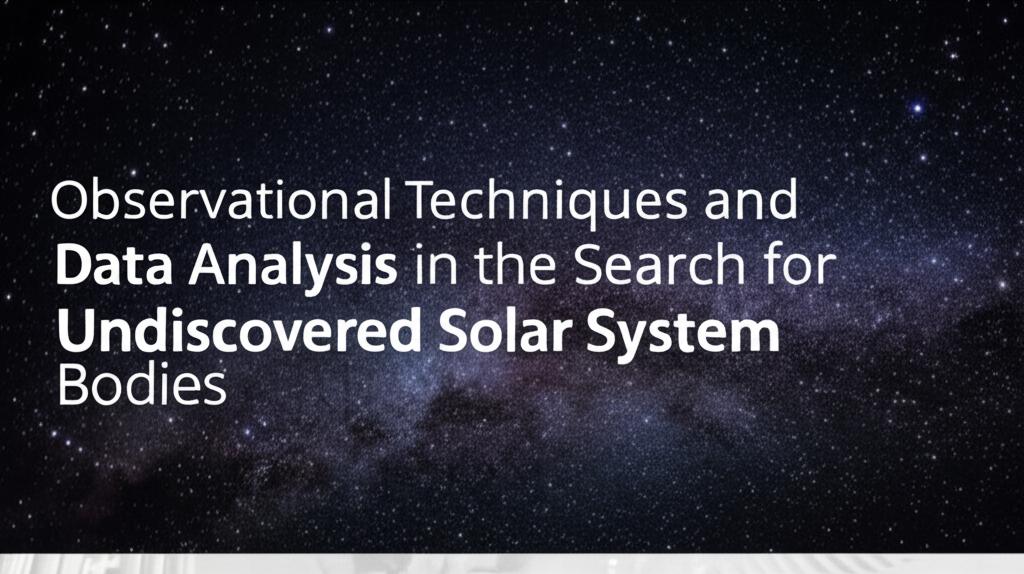Our Solar System, while familiar in many ways, still holds secrets in its vast, dark corners. The quest to discover new objects – from small asteroids and comets to potentially larger bodies like the hypothesized Planet Nine – relies on increasingly sophisticated observational techniques and powerful data analysis methods.
Observational Approaches: Casting a Wide NetModern searches for undiscovered Solar System bodies primarily utilize wide-field surveys. Instead of focusing on specific known objects, powerful telescopes repeatedly scan large swathes of the sky. Key techniques include:
- Wide-Field Imaging: Telescopes equipped with large cameras capture images covering significant portions of the sky. By taking multiple images of the same region over time (hours, days, or weeks apart), astronomers can spot objects moving relative to the distant, fixed stars. This apparent motion is the tell-tale sign of a Solar System body. Ground-based telescopes like the Pan-STARRS MROI Telescope and the Zwicky Transient Facility (ZTF), along with space telescopes like Hubble and the James Webb Space Telescope (JWST), contribute significantly. Upcoming facilities like the Vera C. Rubin Observatory are expected to revolutionize this field with unprecedented depth and breadth.
- Occultation Monitoring: This method involves monitoring large numbers of stars for tiny, brief dips in brightness. These dips can occur when a Solar System object passes directly between the star and the observer on Earth, momentarily blocking the starlight. This technique is particularly effective for detecting very distant and small objects in the Kuiper Belt and beyond, which might be too faint to see directly through reflected sunlight.
- Thermal Emission Detection: Some telescopes, particularly space-based ones like WISE (Wide-field Infrared Survey Explorer) and Spitzer (before its decommissioning), observe in infrared wavelengths. This allows them to detect the faint heat emitted by Solar System objects themselves, rather than just reflected sunlight. This can be advantageous for finding dark objects or those far from the Sun.
The sheer volume of data generated by modern surveys presents a massive challenge. A single night's observation can produce terabytes of images containing millions of potential sources. Sophisticated data analysis is crucial:
- Automated Detection Pipelines: Software algorithms automatically process the incoming images. They perform tasks like subtracting images taken at different times to highlight moving objects, identifying potential candidates based on their movement patterns, and rejecting false positives caused by cosmic rays, satellite trails, or instrument defects.
- Orbit Determination: Once a candidate moving object is identified across multiple images, its preliminary orbit is calculated. This involves complex mathematical modeling to determine the object's path around the Sun, predict its future position, and assess whether it's a truly new discovery or a re-observation of a known object.
- Machine Learning and AI: Increasingly, machine learning techniques are being employed to improve the efficiency and accuracy of detection pipelines. AI can be trained to recognize the subtle signatures of moving objects amidst noisy data, potentially spotting candidates that traditional algorithms might miss.
- Citizen Science: Projects like Zooniverse's "Backyard Worlds: Planet 9" engage the public in visually inspecting survey images. Human eyes are still remarkably good at pattern recognition and can spot faint, slow-moving objects that automated systems might overlook. Citizen scientists have contributed to numerous discoveries of brown dwarfs and potential Solar System objects.
- Dynamical Analysis: Beyond direct detection, astronomers analyze the orbits of known distant objects, particularly Trans-Neptunian Objects (TNOs). Peculiar alignments or clustering in the orbits of these objects can hint at the gravitational influence of a large, unseen body – the primary line of evidence supporting the Planet Nine hypothesis. Simulating the Solar System's gravitational interactions helps constrain the possible location and mass of such undiscovered planets.
Detecting faint, distant objects remains incredibly challenging due to their slow apparent motion and low brightness. Distinguishing them from background noise and artefacts requires meticulous observation and analysis. However, ongoing and future surveys, like the Legacy Survey of Space and Time (LSST) at the Vera C. Rubin Observatory, promise unprecedented depth and data volume. Coupled with advancements in computational power and algorithms, these efforts significantly increase the chances of discovering new members of our Solar System family, potentially rewriting our understanding of its formation and evolution. The search continues, pushing the boundaries of observation and computation to uncover the remaining hidden inhabitants of our cosmic neighborhood.

